MGMT20130 Assessment 2 Report: Lean Six Sigma & Wine Maker Analysis
VerifiedAdded on 2023/06/03
|29
|5803
|50
Report
AI Summary
This report presents a comprehensive analysis of Lean Six Sigma principles within a manufacturing context, emphasizing environmental considerations. The first part of the report explores the application of Lean manufacturing and the Six Sigma approach, using an Indian automotive manufacturing industry as a case study. It addresses waste reduction, process improvement, and environmental sustainability. The report examines the limitations of these techniques and provides recommendations. The second part focuses on business analytics, utilizing Excel Solver to determine the optimal production plan for two wine brands and incorporating sensitivity analysis. The report covers the seven-step modeling process, objective function, decision variables, and constraints, providing a detailed overview of production planning, sensitivity analysis, and decision-making for the winemaker. The report provides a comprehensive understanding of operations management, business analytics, and their application in real-world scenarios, making it a valuable resource for students.
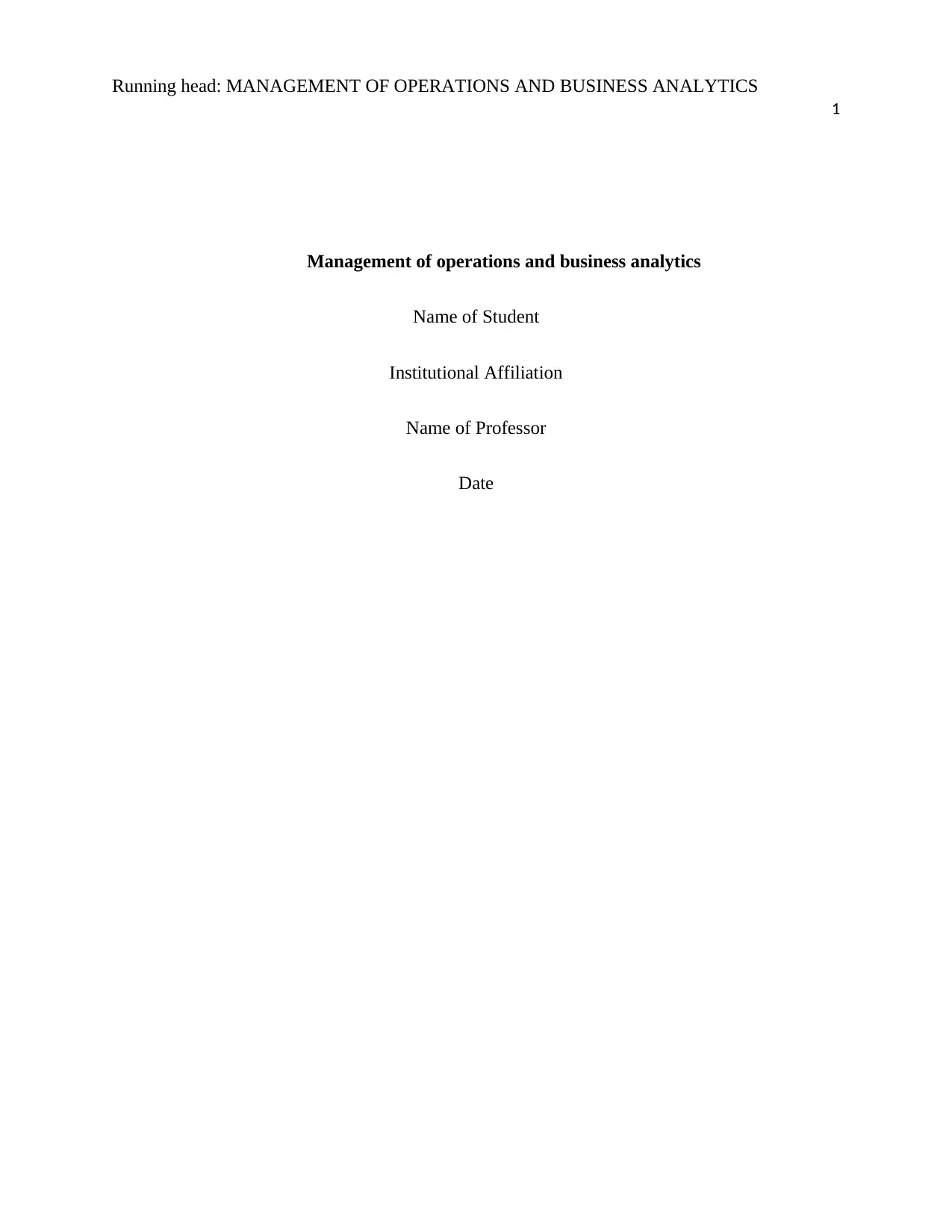
Running head: MANAGEMENT OF OPERATIONS AND BUSINESS ANALYTICS
1
Management of operations and business analytics
Name of Student
Institutional Affiliation
Name of Professor
Date
1
Management of operations and business analytics
Name of Student
Institutional Affiliation
Name of Professor
Date
Paraphrase This Document
Need a fresh take? Get an instant paraphrase of this document with our AI Paraphraser
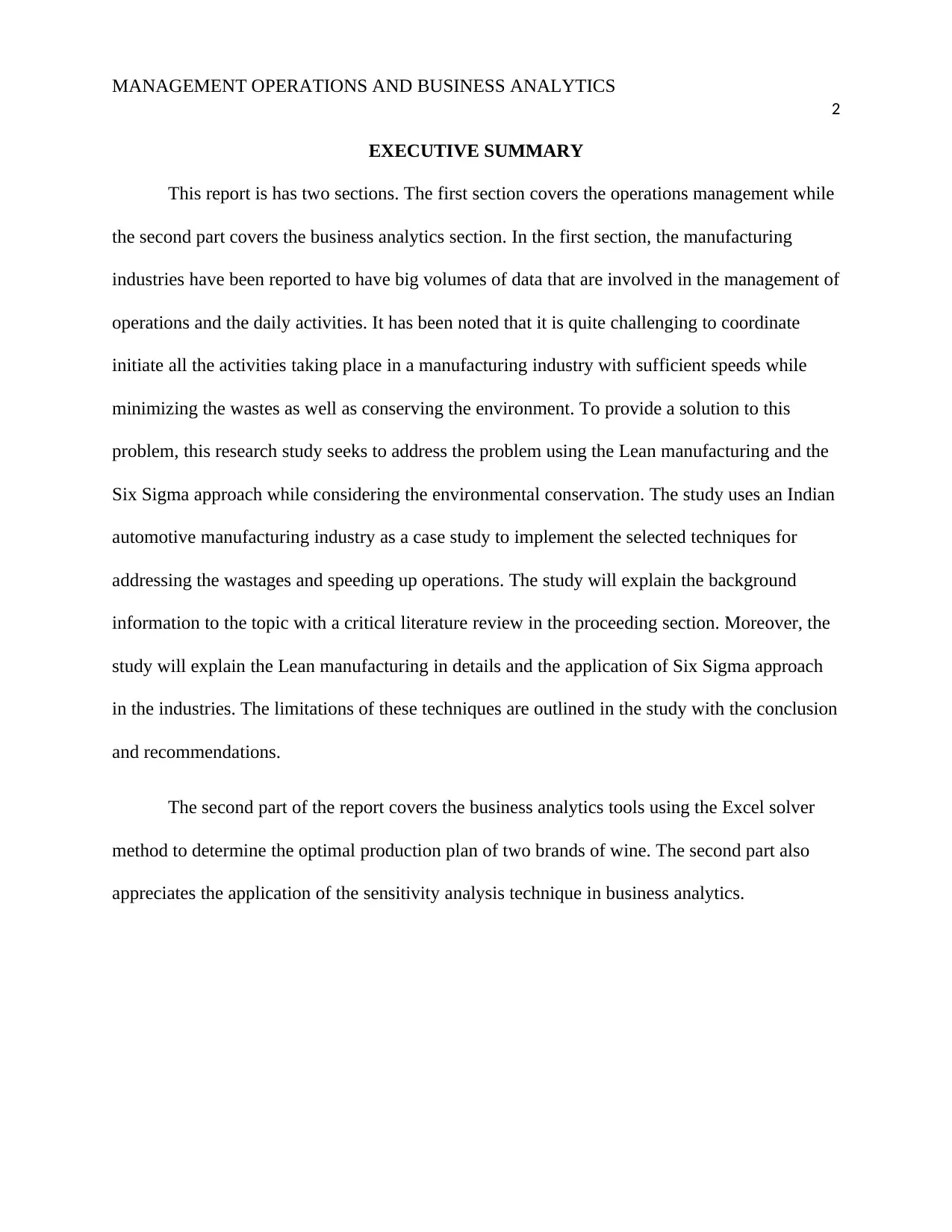
MANAGEMENT OPERATIONS AND BUSINESS ANALYTICS
2
EXECUTIVE SUMMARY
This report is has two sections. The first section covers the operations management while
the second part covers the business analytics section. In the first section, the manufacturing
industries have been reported to have big volumes of data that are involved in the management of
operations and the daily activities. It has been noted that it is quite challenging to coordinate
initiate all the activities taking place in a manufacturing industry with sufficient speeds while
minimizing the wastes as well as conserving the environment. To provide a solution to this
problem, this research study seeks to address the problem using the Lean manufacturing and the
Six Sigma approach while considering the environmental conservation. The study uses an Indian
automotive manufacturing industry as a case study to implement the selected techniques for
addressing the wastages and speeding up operations. The study will explain the background
information to the topic with a critical literature review in the proceeding section. Moreover, the
study will explain the Lean manufacturing in details and the application of Six Sigma approach
in the industries. The limitations of these techniques are outlined in the study with the conclusion
and recommendations.
The second part of the report covers the business analytics tools using the Excel solver
method to determine the optimal production plan of two brands of wine. The second part also
appreciates the application of the sensitivity analysis technique in business analytics.
2
EXECUTIVE SUMMARY
This report is has two sections. The first section covers the operations management while
the second part covers the business analytics section. In the first section, the manufacturing
industries have been reported to have big volumes of data that are involved in the management of
operations and the daily activities. It has been noted that it is quite challenging to coordinate
initiate all the activities taking place in a manufacturing industry with sufficient speeds while
minimizing the wastes as well as conserving the environment. To provide a solution to this
problem, this research study seeks to address the problem using the Lean manufacturing and the
Six Sigma approach while considering the environmental conservation. The study uses an Indian
automotive manufacturing industry as a case study to implement the selected techniques for
addressing the wastages and speeding up operations. The study will explain the background
information to the topic with a critical literature review in the proceeding section. Moreover, the
study will explain the Lean manufacturing in details and the application of Six Sigma approach
in the industries. The limitations of these techniques are outlined in the study with the conclusion
and recommendations.
The second part of the report covers the business analytics tools using the Excel solver
method to determine the optimal production plan of two brands of wine. The second part also
appreciates the application of the sensitivity analysis technique in business analytics.
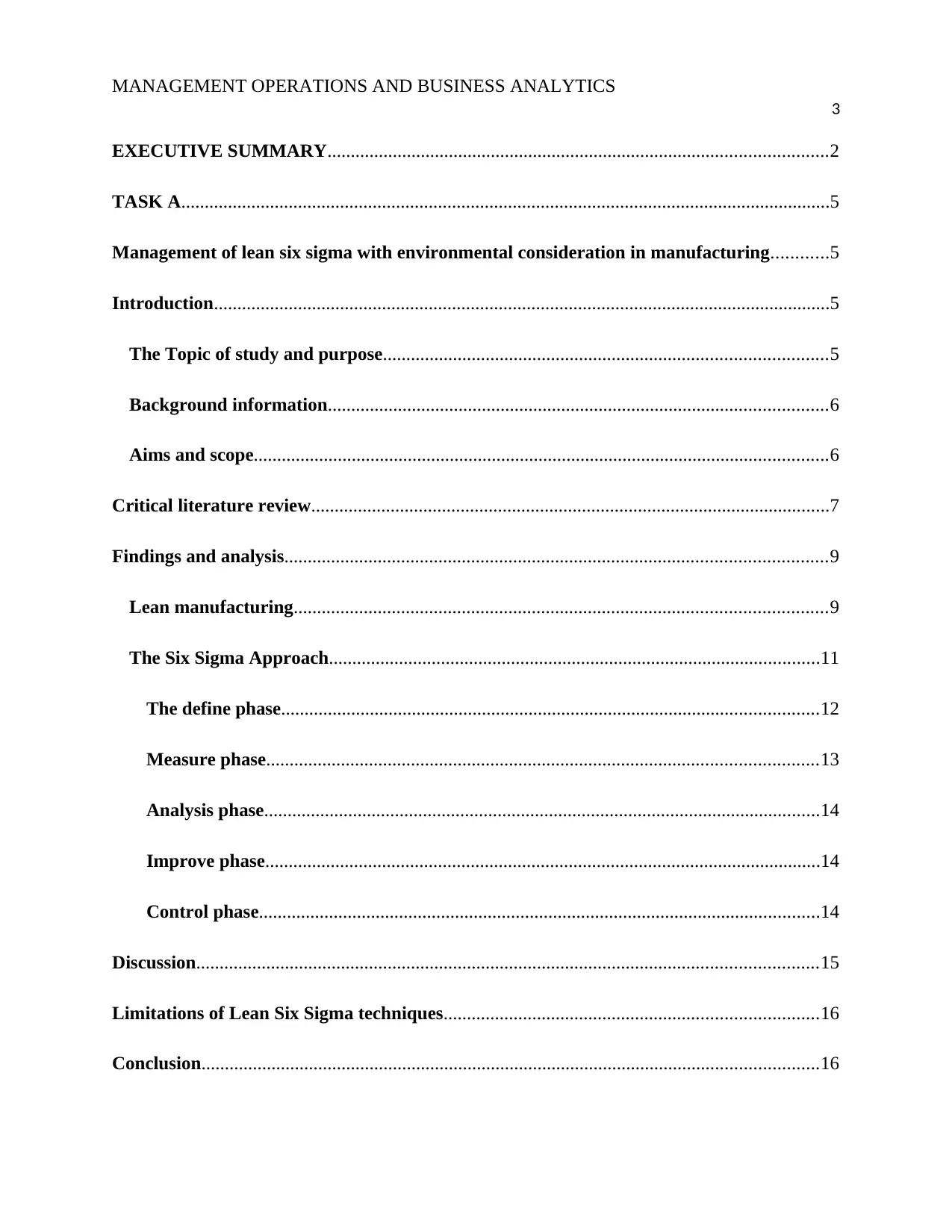
MANAGEMENT OPERATIONS AND BUSINESS ANALYTICS
3
EXECUTIVE SUMMARY...........................................................................................................2
TASK A...........................................................................................................................................5
Management of lean six sigma with environmental consideration in manufacturing............5
Introduction....................................................................................................................................5
The Topic of study and purpose...............................................................................................5
Background information...........................................................................................................6
Aims and scope...........................................................................................................................6
Critical literature review...............................................................................................................7
Findings and analysis....................................................................................................................9
Lean manufacturing..................................................................................................................9
The Six Sigma Approach.........................................................................................................11
The define phase...................................................................................................................12
Measure phase......................................................................................................................13
Analysis phase.......................................................................................................................14
Improve phase.......................................................................................................................14
Control phase........................................................................................................................14
Discussion.....................................................................................................................................15
Limitations of Lean Six Sigma techniques................................................................................16
Conclusion....................................................................................................................................16
3
EXECUTIVE SUMMARY...........................................................................................................2
TASK A...........................................................................................................................................5
Management of lean six sigma with environmental consideration in manufacturing............5
Introduction....................................................................................................................................5
The Topic of study and purpose...............................................................................................5
Background information...........................................................................................................6
Aims and scope...........................................................................................................................6
Critical literature review...............................................................................................................7
Findings and analysis....................................................................................................................9
Lean manufacturing..................................................................................................................9
The Six Sigma Approach.........................................................................................................11
The define phase...................................................................................................................12
Measure phase......................................................................................................................13
Analysis phase.......................................................................................................................14
Improve phase.......................................................................................................................14
Control phase........................................................................................................................14
Discussion.....................................................................................................................................15
Limitations of Lean Six Sigma techniques................................................................................16
Conclusion....................................................................................................................................16
⊘ This is a preview!⊘
Do you want full access?
Subscribe today to unlock all pages.

Trusted by 1+ million students worldwide
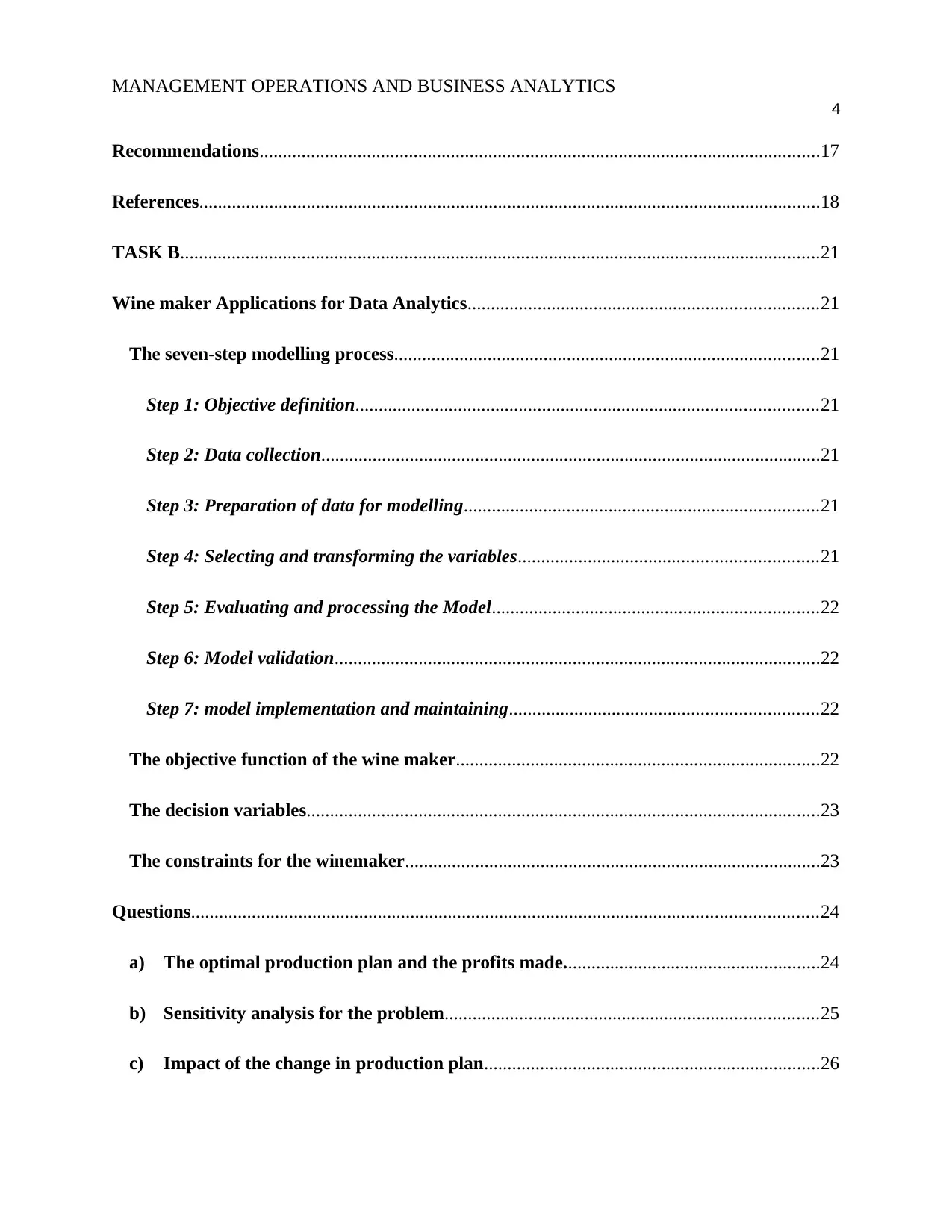
MANAGEMENT OPERATIONS AND BUSINESS ANALYTICS
4
Recommendations........................................................................................................................17
References.....................................................................................................................................18
TASK B.........................................................................................................................................21
Wine maker Applications for Data Analytics...........................................................................21
The seven-step modelling process...........................................................................................21
Step 1: Objective definition...................................................................................................21
Step 2: Data collection...........................................................................................................21
Step 3: Preparation of data for modelling............................................................................21
Step 4: Selecting and transforming the variables................................................................21
Step 5: Evaluating and processing the Model......................................................................22
Step 6: Model validation........................................................................................................22
Step 7: model implementation and maintaining..................................................................22
The objective function of the wine maker..............................................................................22
The decision variables..............................................................................................................23
The constraints for the winemaker.........................................................................................23
Questions......................................................................................................................................24
a) The optimal production plan and the profits made.......................................................24
b) Sensitivity analysis for the problem................................................................................25
c) Impact of the change in production plan........................................................................26
4
Recommendations........................................................................................................................17
References.....................................................................................................................................18
TASK B.........................................................................................................................................21
Wine maker Applications for Data Analytics...........................................................................21
The seven-step modelling process...........................................................................................21
Step 1: Objective definition...................................................................................................21
Step 2: Data collection...........................................................................................................21
Step 3: Preparation of data for modelling............................................................................21
Step 4: Selecting and transforming the variables................................................................21
Step 5: Evaluating and processing the Model......................................................................22
Step 6: Model validation........................................................................................................22
Step 7: model implementation and maintaining..................................................................22
The objective function of the wine maker..............................................................................22
The decision variables..............................................................................................................23
The constraints for the winemaker.........................................................................................23
Questions......................................................................................................................................24
a) The optimal production plan and the profits made.......................................................24
b) Sensitivity analysis for the problem................................................................................25
c) Impact of the change in production plan........................................................................26
Paraphrase This Document
Need a fresh take? Get an instant paraphrase of this document with our AI Paraphraser
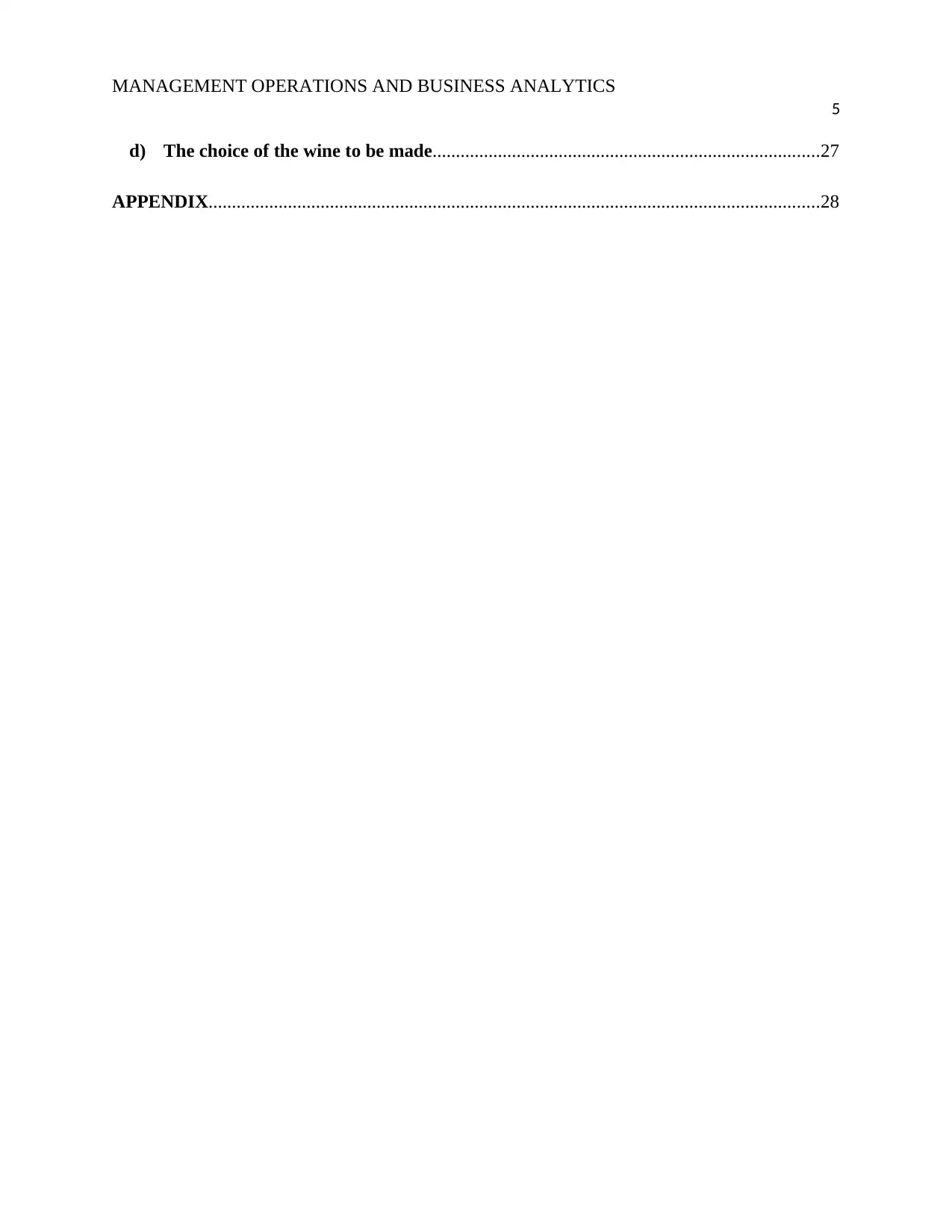
MANAGEMENT OPERATIONS AND BUSINESS ANALYTICS
5
d) The choice of the wine to be made...................................................................................27
APPENDIX...................................................................................................................................28
5
d) The choice of the wine to be made...................................................................................27
APPENDIX...................................................................................................................................28
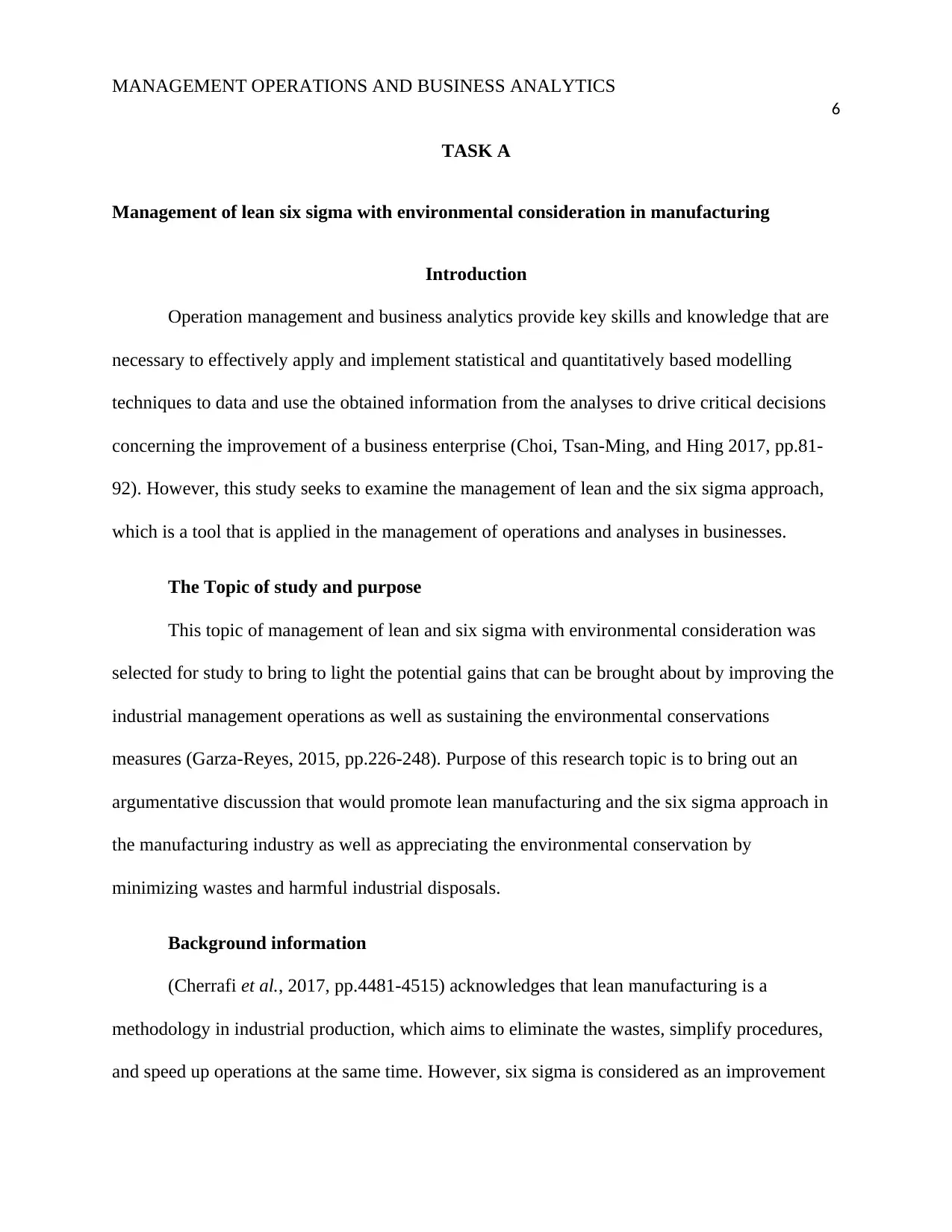
MANAGEMENT OPERATIONS AND BUSINESS ANALYTICS
6
TASK A
Management of lean six sigma with environmental consideration in manufacturing
Introduction
Operation management and business analytics provide key skills and knowledge that are
necessary to effectively apply and implement statistical and quantitatively based modelling
techniques to data and use the obtained information from the analyses to drive critical decisions
concerning the improvement of a business enterprise (Choi, Tsan-Ming, and Hing 2017, pp.81-
92). However, this study seeks to examine the management of lean and the six sigma approach,
which is a tool that is applied in the management of operations and analyses in businesses.
The Topic of study and purpose
This topic of management of lean and six sigma with environmental consideration was
selected for study to bring to light the potential gains that can be brought about by improving the
industrial management operations as well as sustaining the environmental conservations
measures (Garza-Reyes, 2015, pp.226-248). Purpose of this research topic is to bring out an
argumentative discussion that would promote lean manufacturing and the six sigma approach in
the manufacturing industry as well as appreciating the environmental conservation by
minimizing wastes and harmful industrial disposals.
Background information
(Cherrafi et al., 2017, pp.4481-4515) acknowledges that lean manufacturing is a
methodology in industrial production, which aims to eliminate the wastes, simplify procedures,
and speed up operations at the same time. However, six sigma is considered as an improvement
6
TASK A
Management of lean six sigma with environmental consideration in manufacturing
Introduction
Operation management and business analytics provide key skills and knowledge that are
necessary to effectively apply and implement statistical and quantitatively based modelling
techniques to data and use the obtained information from the analyses to drive critical decisions
concerning the improvement of a business enterprise (Choi, Tsan-Ming, and Hing 2017, pp.81-
92). However, this study seeks to examine the management of lean and the six sigma approach,
which is a tool that is applied in the management of operations and analyses in businesses.
The Topic of study and purpose
This topic of management of lean and six sigma with environmental consideration was
selected for study to bring to light the potential gains that can be brought about by improving the
industrial management operations as well as sustaining the environmental conservations
measures (Garza-Reyes, 2015, pp.226-248). Purpose of this research topic is to bring out an
argumentative discussion that would promote lean manufacturing and the six sigma approach in
the manufacturing industry as well as appreciating the environmental conservation by
minimizing wastes and harmful industrial disposals.
Background information
(Cherrafi et al., 2017, pp.4481-4515) acknowledges that lean manufacturing is a
methodology in industrial production, which aims to eliminate the wastes, simplify procedures,
and speed up operations at the same time. However, six sigma is considered as an improvement
⊘ This is a preview!⊘
Do you want full access?
Subscribe today to unlock all pages.

Trusted by 1+ million students worldwide
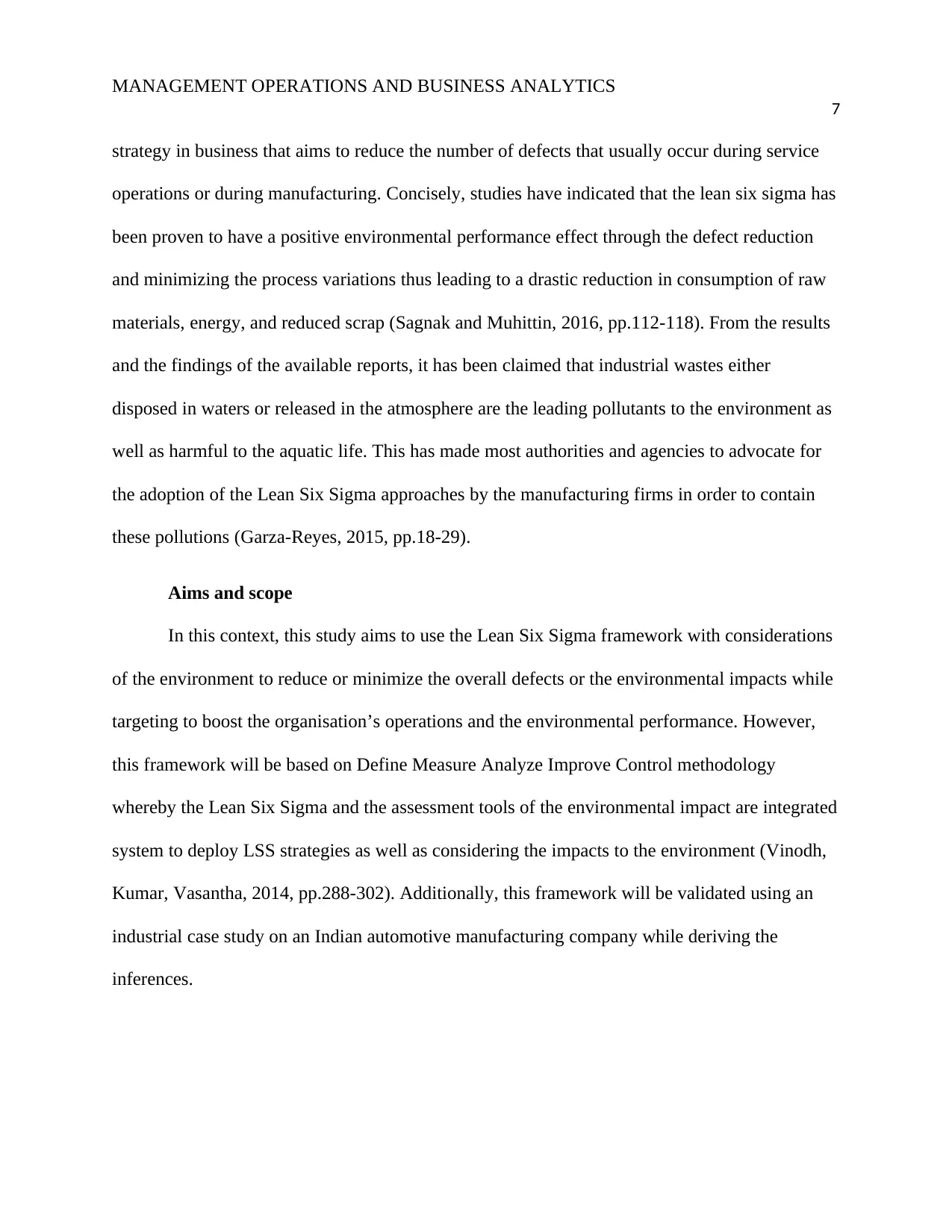
MANAGEMENT OPERATIONS AND BUSINESS ANALYTICS
7
strategy in business that aims to reduce the number of defects that usually occur during service
operations or during manufacturing. Concisely, studies have indicated that the lean six sigma has
been proven to have a positive environmental performance effect through the defect reduction
and minimizing the process variations thus leading to a drastic reduction in consumption of raw
materials, energy, and reduced scrap (Sagnak and Muhittin, 2016, pp.112-118). From the results
and the findings of the available reports, it has been claimed that industrial wastes either
disposed in waters or released in the atmosphere are the leading pollutants to the environment as
well as harmful to the aquatic life. This has made most authorities and agencies to advocate for
the adoption of the Lean Six Sigma approaches by the manufacturing firms in order to contain
these pollutions (Garza-Reyes, 2015, pp.18-29).
Aims and scope
In this context, this study aims to use the Lean Six Sigma framework with considerations
of the environment to reduce or minimize the overall defects or the environmental impacts while
targeting to boost the organisation’s operations and the environmental performance. However,
this framework will be based on Define Measure Analyze Improve Control methodology
whereby the Lean Six Sigma and the assessment tools of the environmental impact are integrated
system to deploy LSS strategies as well as considering the impacts to the environment (Vinodh,
Kumar, Vasantha, 2014, pp.288-302). Additionally, this framework will be validated using an
industrial case study on an Indian automotive manufacturing company while deriving the
inferences.
7
strategy in business that aims to reduce the number of defects that usually occur during service
operations or during manufacturing. Concisely, studies have indicated that the lean six sigma has
been proven to have a positive environmental performance effect through the defect reduction
and minimizing the process variations thus leading to a drastic reduction in consumption of raw
materials, energy, and reduced scrap (Sagnak and Muhittin, 2016, pp.112-118). From the results
and the findings of the available reports, it has been claimed that industrial wastes either
disposed in waters or released in the atmosphere are the leading pollutants to the environment as
well as harmful to the aquatic life. This has made most authorities and agencies to advocate for
the adoption of the Lean Six Sigma approaches by the manufacturing firms in order to contain
these pollutions (Garza-Reyes, 2015, pp.18-29).
Aims and scope
In this context, this study aims to use the Lean Six Sigma framework with considerations
of the environment to reduce or minimize the overall defects or the environmental impacts while
targeting to boost the organisation’s operations and the environmental performance. However,
this framework will be based on Define Measure Analyze Improve Control methodology
whereby the Lean Six Sigma and the assessment tools of the environmental impact are integrated
system to deploy LSS strategies as well as considering the impacts to the environment (Vinodh,
Kumar, Vasantha, 2014, pp.288-302). Additionally, this framework will be validated using an
industrial case study on an Indian automotive manufacturing company while deriving the
inferences.
Paraphrase This Document
Need a fresh take? Get an instant paraphrase of this document with our AI Paraphraser
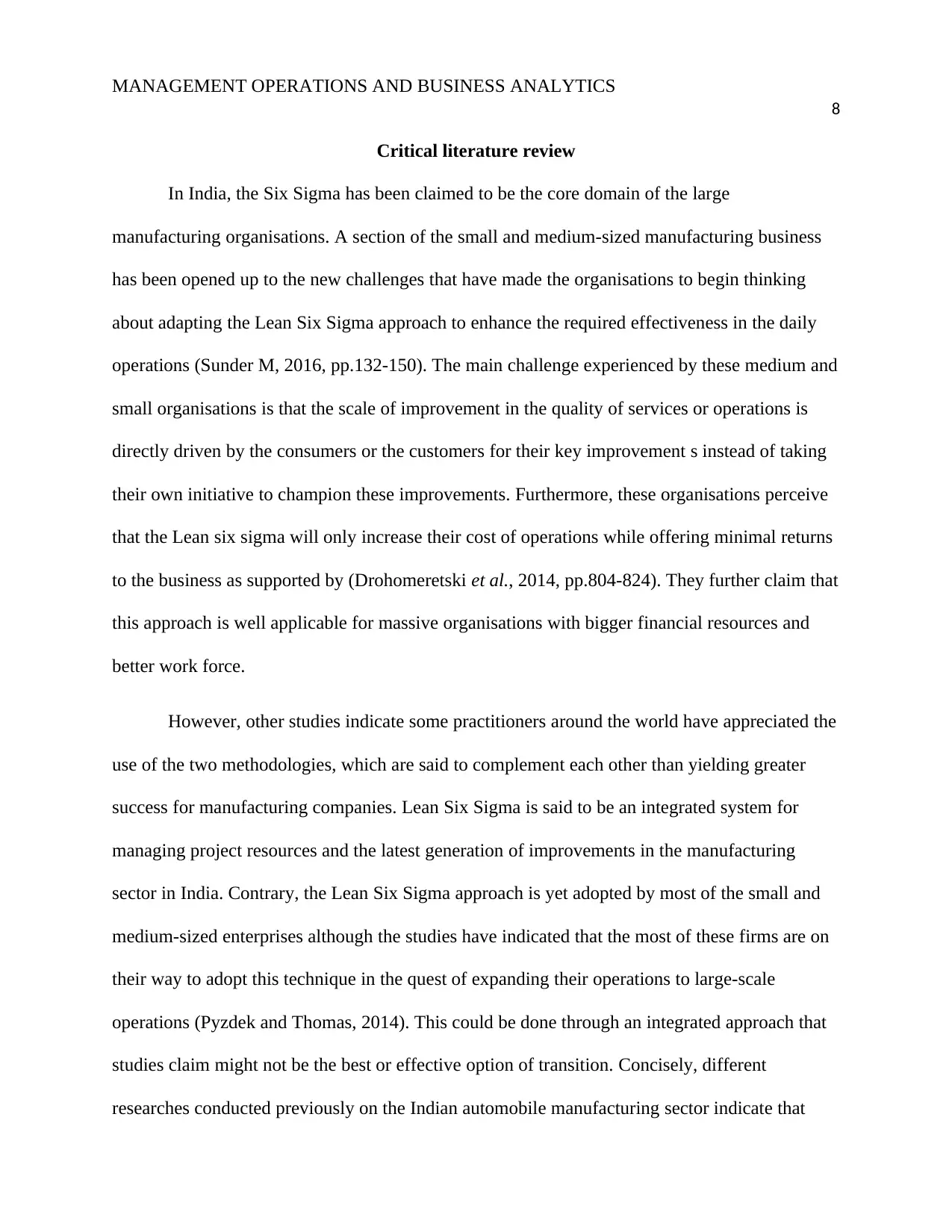
MANAGEMENT OPERATIONS AND BUSINESS ANALYTICS
8
Critical literature review
In India, the Six Sigma has been claimed to be the core domain of the large
manufacturing organisations. A section of the small and medium-sized manufacturing business
has been opened up to the new challenges that have made the organisations to begin thinking
about adapting the Lean Six Sigma approach to enhance the required effectiveness in the daily
operations (Sunder M, 2016, pp.132-150). The main challenge experienced by these medium and
small organisations is that the scale of improvement in the quality of services or operations is
directly driven by the consumers or the customers for their key improvement s instead of taking
their own initiative to champion these improvements. Furthermore, these organisations perceive
that the Lean six sigma will only increase their cost of operations while offering minimal returns
to the business as supported by (Drohomeretski et al., 2014, pp.804-824). They further claim that
this approach is well applicable for massive organisations with bigger financial resources and
better work force.
However, other studies indicate some practitioners around the world have appreciated the
use of the two methodologies, which are said to complement each other than yielding greater
success for manufacturing companies. Lean Six Sigma is said to be an integrated system for
managing project resources and the latest generation of improvements in the manufacturing
sector in India. Contrary, the Lean Six Sigma approach is yet adopted by most of the small and
medium-sized enterprises although the studies have indicated that the most of these firms are on
their way to adopt this technique in the quest of expanding their operations to large-scale
operations (Pyzdek and Thomas, 2014). This could be done through an integrated approach that
studies claim might not be the best or effective option of transition. Concisely, different
researches conducted previously on the Indian automobile manufacturing sector indicate that
8
Critical literature review
In India, the Six Sigma has been claimed to be the core domain of the large
manufacturing organisations. A section of the small and medium-sized manufacturing business
has been opened up to the new challenges that have made the organisations to begin thinking
about adapting the Lean Six Sigma approach to enhance the required effectiveness in the daily
operations (Sunder M, 2016, pp.132-150). The main challenge experienced by these medium and
small organisations is that the scale of improvement in the quality of services or operations is
directly driven by the consumers or the customers for their key improvement s instead of taking
their own initiative to champion these improvements. Furthermore, these organisations perceive
that the Lean six sigma will only increase their cost of operations while offering minimal returns
to the business as supported by (Drohomeretski et al., 2014, pp.804-824). They further claim that
this approach is well applicable for massive organisations with bigger financial resources and
better work force.
However, other studies indicate some practitioners around the world have appreciated the
use of the two methodologies, which are said to complement each other than yielding greater
success for manufacturing companies. Lean Six Sigma is said to be an integrated system for
managing project resources and the latest generation of improvements in the manufacturing
sector in India. Contrary, the Lean Six Sigma approach is yet adopted by most of the small and
medium-sized enterprises although the studies have indicated that the most of these firms are on
their way to adopt this technique in the quest of expanding their operations to large-scale
operations (Pyzdek and Thomas, 2014). This could be done through an integrated approach that
studies claim might not be the best or effective option of transition. Concisely, different
researches conducted previously on the Indian automobile manufacturing sector indicate that
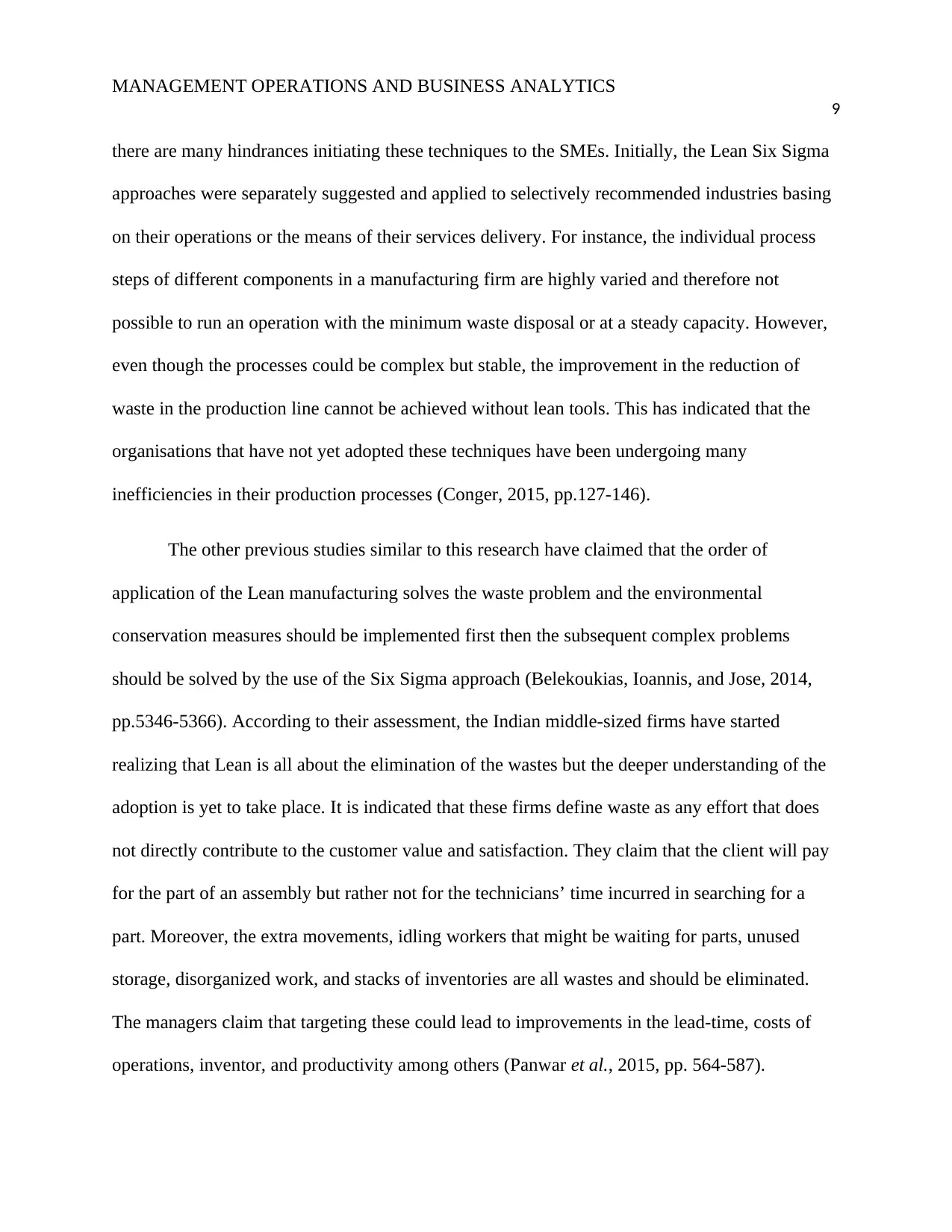
MANAGEMENT OPERATIONS AND BUSINESS ANALYTICS
9
there are many hindrances initiating these techniques to the SMEs. Initially, the Lean Six Sigma
approaches were separately suggested and applied to selectively recommended industries basing
on their operations or the means of their services delivery. For instance, the individual process
steps of different components in a manufacturing firm are highly varied and therefore not
possible to run an operation with the minimum waste disposal or at a steady capacity. However,
even though the processes could be complex but stable, the improvement in the reduction of
waste in the production line cannot be achieved without lean tools. This has indicated that the
organisations that have not yet adopted these techniques have been undergoing many
inefficiencies in their production processes (Conger, 2015, pp.127-146).
The other previous studies similar to this research have claimed that the order of
application of the Lean manufacturing solves the waste problem and the environmental
conservation measures should be implemented first then the subsequent complex problems
should be solved by the use of the Six Sigma approach (Belekoukias, Ioannis, and Jose, 2014,
pp.5346-5366). According to their assessment, the Indian middle-sized firms have started
realizing that Lean is all about the elimination of the wastes but the deeper understanding of the
adoption is yet to take place. It is indicated that these firms define waste as any effort that does
not directly contribute to the customer value and satisfaction. They claim that the client will pay
for the part of an assembly but rather not for the technicians’ time incurred in searching for a
part. Moreover, the extra movements, idling workers that might be waiting for parts, unused
storage, disorganized work, and stacks of inventories are all wastes and should be eliminated.
The managers claim that targeting these could lead to improvements in the lead-time, costs of
operations, inventor, and productivity among others (Panwar et al., 2015, pp. 564-587).
9
there are many hindrances initiating these techniques to the SMEs. Initially, the Lean Six Sigma
approaches were separately suggested and applied to selectively recommended industries basing
on their operations or the means of their services delivery. For instance, the individual process
steps of different components in a manufacturing firm are highly varied and therefore not
possible to run an operation with the minimum waste disposal or at a steady capacity. However,
even though the processes could be complex but stable, the improvement in the reduction of
waste in the production line cannot be achieved without lean tools. This has indicated that the
organisations that have not yet adopted these techniques have been undergoing many
inefficiencies in their production processes (Conger, 2015, pp.127-146).
The other previous studies similar to this research have claimed that the order of
application of the Lean manufacturing solves the waste problem and the environmental
conservation measures should be implemented first then the subsequent complex problems
should be solved by the use of the Six Sigma approach (Belekoukias, Ioannis, and Jose, 2014,
pp.5346-5366). According to their assessment, the Indian middle-sized firms have started
realizing that Lean is all about the elimination of the wastes but the deeper understanding of the
adoption is yet to take place. It is indicated that these firms define waste as any effort that does
not directly contribute to the customer value and satisfaction. They claim that the client will pay
for the part of an assembly but rather not for the technicians’ time incurred in searching for a
part. Moreover, the extra movements, idling workers that might be waiting for parts, unused
storage, disorganized work, and stacks of inventories are all wastes and should be eliminated.
The managers claim that targeting these could lead to improvements in the lead-time, costs of
operations, inventor, and productivity among others (Panwar et al., 2015, pp. 564-587).
⊘ This is a preview!⊘
Do you want full access?
Subscribe today to unlock all pages.

Trusted by 1+ million students worldwide
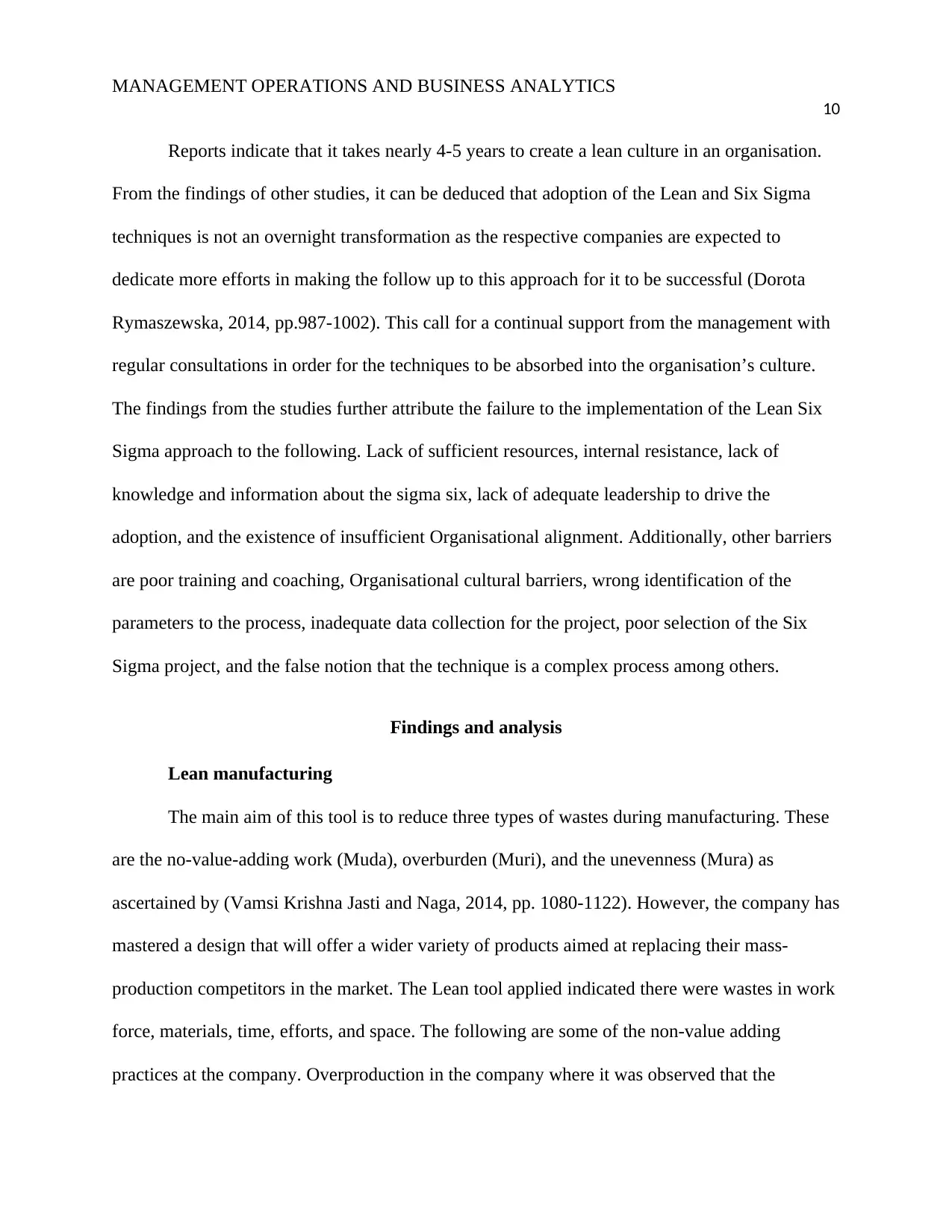
MANAGEMENT OPERATIONS AND BUSINESS ANALYTICS
10
Reports indicate that it takes nearly 4-5 years to create a lean culture in an organisation.
From the findings of other studies, it can be deduced that adoption of the Lean and Six Sigma
techniques is not an overnight transformation as the respective companies are expected to
dedicate more efforts in making the follow up to this approach for it to be successful (Dorota
Rymaszewska, 2014, pp.987-1002). This call for a continual support from the management with
regular consultations in order for the techniques to be absorbed into the organisation’s culture.
The findings from the studies further attribute the failure to the implementation of the Lean Six
Sigma approach to the following. Lack of sufficient resources, internal resistance, lack of
knowledge and information about the sigma six, lack of adequate leadership to drive the
adoption, and the existence of insufficient Organisational alignment. Additionally, other barriers
are poor training and coaching, Organisational cultural barriers, wrong identification of the
parameters to the process, inadequate data collection for the project, poor selection of the Six
Sigma project, and the false notion that the technique is a complex process among others.
Findings and analysis
Lean manufacturing
The main aim of this tool is to reduce three types of wastes during manufacturing. These
are the no-value-adding work (Muda), overburden (Muri), and the unevenness (Mura) as
ascertained by (Vamsi Krishna Jasti and Naga, 2014, pp. 1080-1122). However, the company has
mastered a design that will offer a wider variety of products aimed at replacing their mass-
production competitors in the market. The Lean tool applied indicated there were wastes in work
force, materials, time, efforts, and space. The following are some of the non-value adding
practices at the company. Overproduction in the company where it was observed that the
10
Reports indicate that it takes nearly 4-5 years to create a lean culture in an organisation.
From the findings of other studies, it can be deduced that adoption of the Lean and Six Sigma
techniques is not an overnight transformation as the respective companies are expected to
dedicate more efforts in making the follow up to this approach for it to be successful (Dorota
Rymaszewska, 2014, pp.987-1002). This call for a continual support from the management with
regular consultations in order for the techniques to be absorbed into the organisation’s culture.
The findings from the studies further attribute the failure to the implementation of the Lean Six
Sigma approach to the following. Lack of sufficient resources, internal resistance, lack of
knowledge and information about the sigma six, lack of adequate leadership to drive the
adoption, and the existence of insufficient Organisational alignment. Additionally, other barriers
are poor training and coaching, Organisational cultural barriers, wrong identification of the
parameters to the process, inadequate data collection for the project, poor selection of the Six
Sigma project, and the false notion that the technique is a complex process among others.
Findings and analysis
Lean manufacturing
The main aim of this tool is to reduce three types of wastes during manufacturing. These
are the no-value-adding work (Muda), overburden (Muri), and the unevenness (Mura) as
ascertained by (Vamsi Krishna Jasti and Naga, 2014, pp. 1080-1122). However, the company has
mastered a design that will offer a wider variety of products aimed at replacing their mass-
production competitors in the market. The Lean tool applied indicated there were wastes in work
force, materials, time, efforts, and space. The following are some of the non-value adding
practices at the company. Overproduction in the company where it was observed that the
Paraphrase This Document
Need a fresh take? Get an instant paraphrase of this document with our AI Paraphraser

MANAGEMENT OPERATIONS AND BUSINESS ANALYTICS
11
company was producing more and sooner than the customer needs. Another practice was the
waiting time for the machinery, tools, raw materials, and maintenance among others. Moreover,
the transportation of the materials and people over long distances was also considered to be non-
value adding to the company (Kurdve et al., 2014, pp.180-190). The inappropriate or inefficient
processing was also categorized as non-value adding with the work-in-progress inventories
causing extra handling, space, and the costs. Moreover, excess and unnecessary motion of the
people and machinery that does not add value to the services or products were termed as
wastage. The defective products such as those returned by the customers, rework, customer
dissatisfaction, and scrap was considered as the wastes thus they should be minimized as much
as possible. However, a system was developed in Lean manufacturing to reduce the Muda known
as Just-In-Time that relies on the signals between the different points in a process to determine
when the production will make the next part (Rohani and Jafri, 2015, pp.6-10).
However, according to (Thurston and Joanathan, 2016), the principles of Lean include,
application of the pull system instead of pull, no inventory or the waiting time, reduced processes
cycle, and line balancing. These principles have made the Lean tool to guide the company to
think in the following ways. First, value specification during manufacturing has enabled the
company to deliver the required product to the customers, at the right time, and with quality
customer specifications. The tool has also enabled the company to identify the value stream for
each product, make the value flow without any interruptions, and pursue perfection. Moreover,
the Lean tools adopted by the company include the quick changeover or setup reduction, value
stream mapping, single minute exchange of dies, cellular manufacturing, the Total Productive
Maintenance, and the five S. The 5S tool enabled the company to achieve efficient Organisation,
Orderliness, Cleanliness, Standardized conditions, and Discipline that has enabled the habit of
11
company was producing more and sooner than the customer needs. Another practice was the
waiting time for the machinery, tools, raw materials, and maintenance among others. Moreover,
the transportation of the materials and people over long distances was also considered to be non-
value adding to the company (Kurdve et al., 2014, pp.180-190). The inappropriate or inefficient
processing was also categorized as non-value adding with the work-in-progress inventories
causing extra handling, space, and the costs. Moreover, excess and unnecessary motion of the
people and machinery that does not add value to the services or products were termed as
wastage. The defective products such as those returned by the customers, rework, customer
dissatisfaction, and scrap was considered as the wastes thus they should be minimized as much
as possible. However, a system was developed in Lean manufacturing to reduce the Muda known
as Just-In-Time that relies on the signals between the different points in a process to determine
when the production will make the next part (Rohani and Jafri, 2015, pp.6-10).
However, according to (Thurston and Joanathan, 2016), the principles of Lean include,
application of the pull system instead of pull, no inventory or the waiting time, reduced processes
cycle, and line balancing. These principles have made the Lean tool to guide the company to
think in the following ways. First, value specification during manufacturing has enabled the
company to deliver the required product to the customers, at the right time, and with quality
customer specifications. The tool has also enabled the company to identify the value stream for
each product, make the value flow without any interruptions, and pursue perfection. Moreover,
the Lean tools adopted by the company include the quick changeover or setup reduction, value
stream mapping, single minute exchange of dies, cellular manufacturing, the Total Productive
Maintenance, and the five S. The 5S tool enabled the company to achieve efficient Organisation,
Orderliness, Cleanliness, Standardized conditions, and Discipline that has enabled the habit of
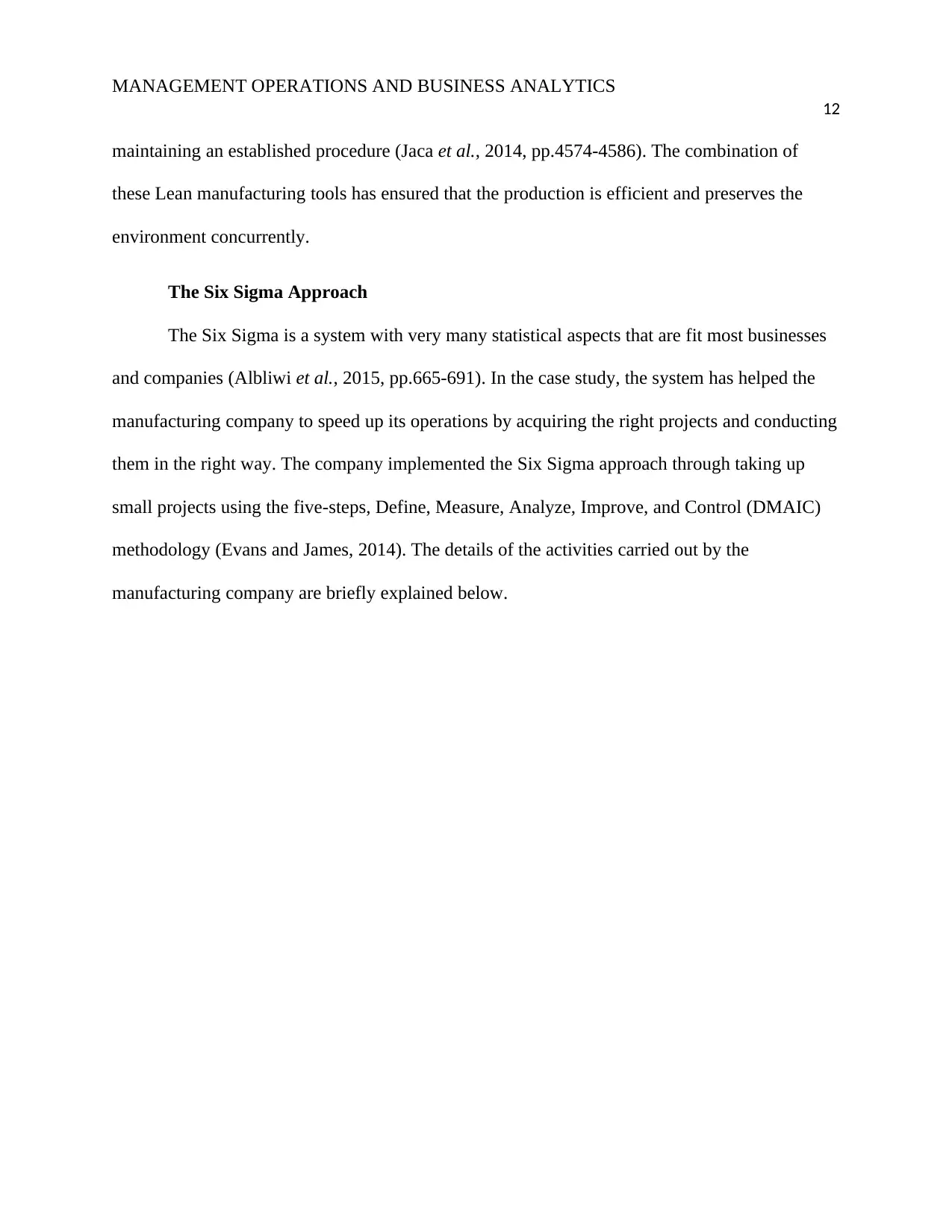
MANAGEMENT OPERATIONS AND BUSINESS ANALYTICS
12
maintaining an established procedure (Jaca et al., 2014, pp.4574-4586). The combination of
these Lean manufacturing tools has ensured that the production is efficient and preserves the
environment concurrently.
The Six Sigma Approach
The Six Sigma is a system with very many statistical aspects that are fit most businesses
and companies (Albliwi et al., 2015, pp.665-691). In the case study, the system has helped the
manufacturing company to speed up its operations by acquiring the right projects and conducting
them in the right way. The company implemented the Six Sigma approach through taking up
small projects using the five-steps, Define, Measure, Analyze, Improve, and Control (DMAIC)
methodology (Evans and James, 2014). The details of the activities carried out by the
manufacturing company are briefly explained below.
12
maintaining an established procedure (Jaca et al., 2014, pp.4574-4586). The combination of
these Lean manufacturing tools has ensured that the production is efficient and preserves the
environment concurrently.
The Six Sigma Approach
The Six Sigma is a system with very many statistical aspects that are fit most businesses
and companies (Albliwi et al., 2015, pp.665-691). In the case study, the system has helped the
manufacturing company to speed up its operations by acquiring the right projects and conducting
them in the right way. The company implemented the Six Sigma approach through taking up
small projects using the five-steps, Define, Measure, Analyze, Improve, and Control (DMAIC)
methodology (Evans and James, 2014). The details of the activities carried out by the
manufacturing company are briefly explained below.
⊘ This is a preview!⊘
Do you want full access?
Subscribe today to unlock all pages.

Trusted by 1+ million students worldwide
1 out of 29
Related Documents
Your All-in-One AI-Powered Toolkit for Academic Success.
+13062052269
info@desklib.com
Available 24*7 on WhatsApp / Email
![[object Object]](/_next/static/media/star-bottom.7253800d.svg)
Unlock your academic potential
Copyright © 2020–2025 A2Z Services. All Rights Reserved. Developed and managed by ZUCOL.




